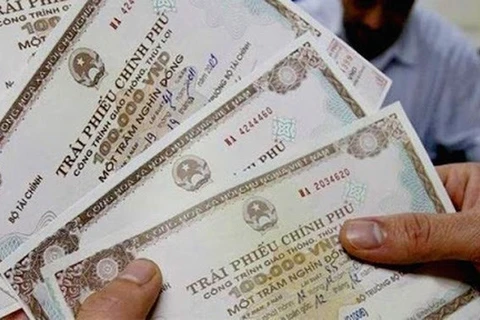 All commodities in the specialised G-bond market have been issued through concentrated auctions since 2006 and listed on the Hanoi Stock Exchange (HNX) since 2008. (Photo: VietnamPlus)
All commodities in the specialised G-bond market have been issued through concentrated auctions since 2006 and listed on the Hanoi Stock Exchange (HNX) since 2008. (Photo: VietnamPlus) Hanoi (VNA) – The Government bond (G-bond) market has affirmed its role as an effective and safe capital mobilisation channel for the State budget, and serves as a reference market for interest rates in financial and commodity markets, said insiders.
The G-bond market has recorded impressive results over the last 14 years. The Vietnamese G-bond market was evaluated by the Asian Development Bank (ADB) as one of the fastest-growing markets in East Asia in 2013, 2014, 2018, and 2019.
However, the size of the G-bond market of Vietnam accounts for only 19.77% of the national GDP, remaining modest compared to other countries in the region such as Singapore (49.6%), Thailand (73%), and the Republic of Korea (73.6%). Therefore, there is still ample room for further development of the market.
Efficient and safe channel for mobilising capital
In addition to the roles mentioned above, the G-bond market is considered an attractive investment channel for investors, especially as the national economy was heavily impacted by the complicated developments of the COVID-19 pandemic.
According to HNX, the value of capital mobilised through G-bond auctions has increased in recent times. The total value of mobilized capital in the first eight months of 2023 reached nearly 235 trillion VND, up 114% compared to the same period last year.
The volume of successful G-bond mobilisation through auctions at HNX has surged to 234.96 trillion VND in 2023 from 2.599 trillion VND in 2009.
According to statistics on the secondary market, as of August 31, 2023, the G-bond market’s value on HNX hit over 1.880 quadrillion VND, equivalent to 19.77% of the GDP in 2022, and up 11.54% compared to 2022, and 11.8 times higher than that reported in 2009.
The total value of the G-bond market in the first eight months of 2023 reached over 953 trillion VND, of which outright transactions accounted for 67.68%. The average trading value reached 5.777 trillion VND per session, surging by 15.8 times compared to 2009. The trading value of foreign investors remained stable, accounting for about 1%-2% of the total value.
Since 2015, large-lot bonds have been issued, thereby reducing the number of bond codes to 300 in 2023 from about 500 codes in 2009. The average value of codes increased about 9 times to about 6 trillion VND per code.
 G-bond trading system meets the information access demand of investors, helping significantly save trading costs and time. - Illustrative image (Photo: VietnamPlus)
G-bond trading system meets the information access demand of investors, helping significantly save trading costs and time. - Illustrative image (Photo: VietnamPlus) Important tool for public debt restructuring
So far, the legal framework for operating the G-bond market has been finalized and adjusted in accordance with each development stage of the market, and international norms and practices.
The G-bond market has become a crucial channel for mobilising medium and long-term capital for the State budget in association with public debt restructuring through the issuance of long-term bonds.
Notably, the G-bond issuance has affirmed its role as a vital tool for public debt restructuring, contributing to reducing the foreign debt ratio from 73.6% in 2010 to 63.4% in 2015 and 34.8% in 2021.
The average deposit interest rate decreased to about 2% in 2021 from 10% in 2009, while the average issuance term extended from 2-3 years (in 2009) to 12.19 years (in 2021), contributing to restructuring public debt in a safe and sustainable direction.
The issuance through auctions on HNX is organized according to a pre-announced annual issuance plan and an expected mobilization plan for each quarter. This allows market participants to proactively prepare their capital for participation./.
























